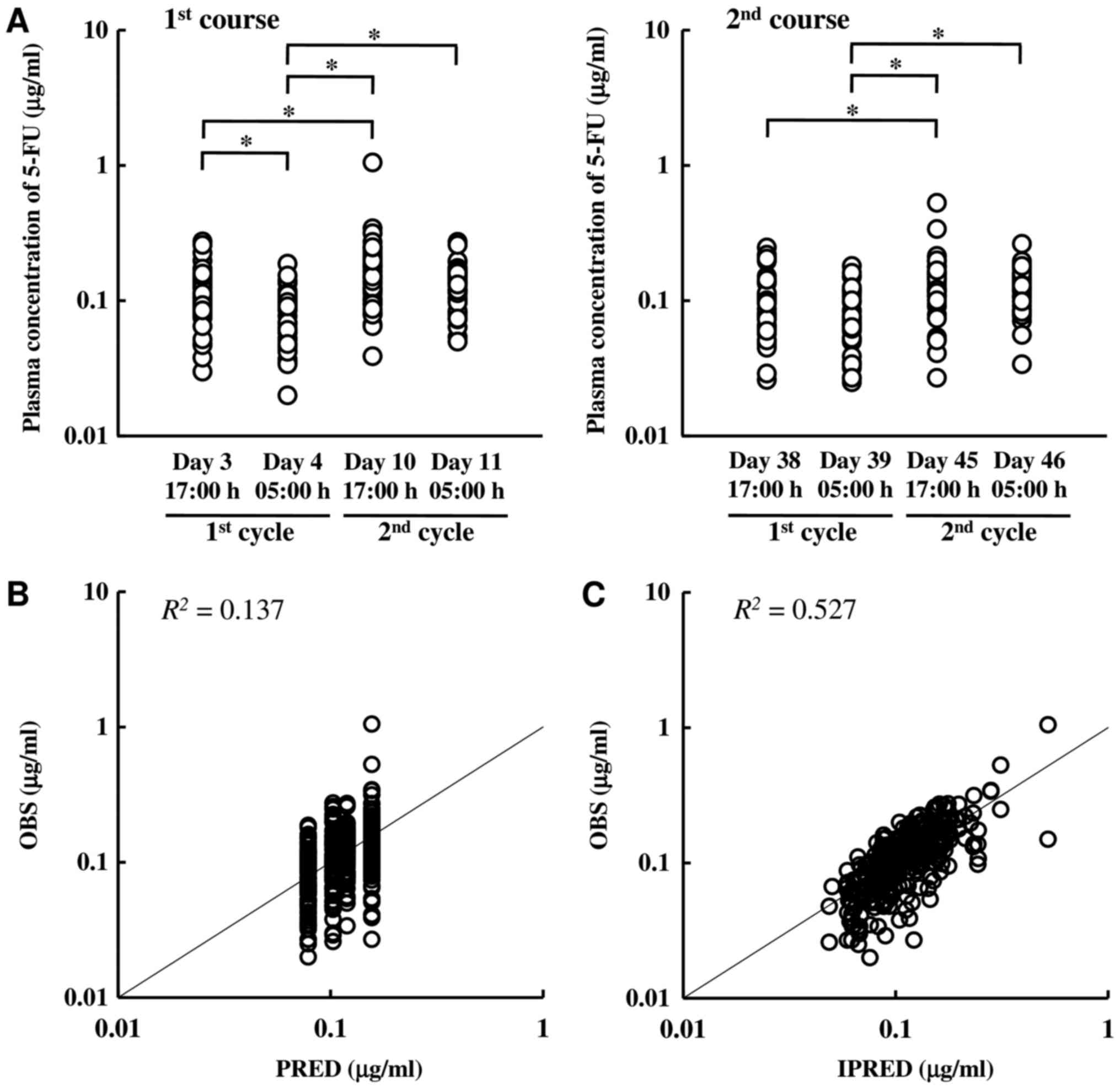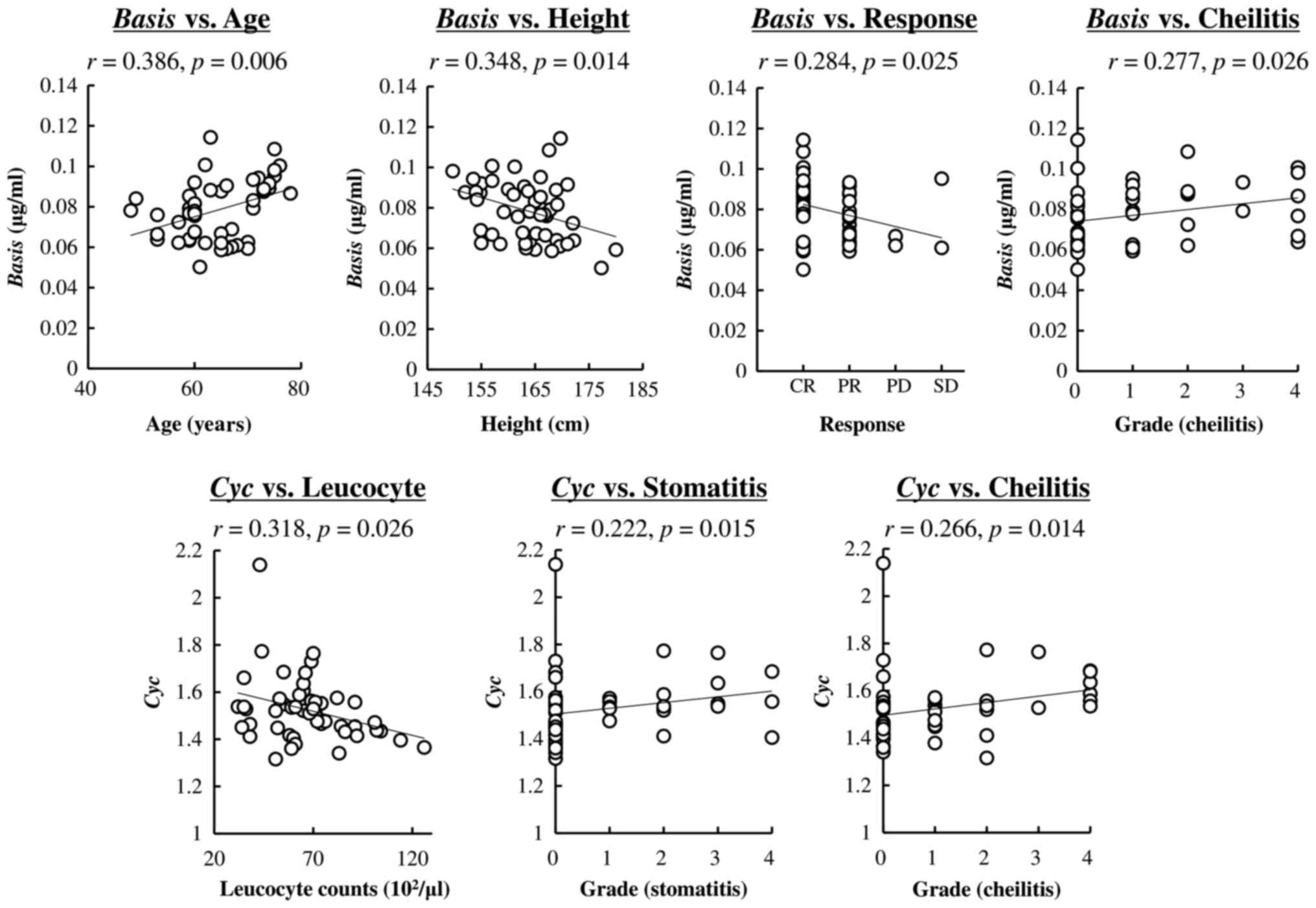|
1
|
Saif MW, Choma A, Salamone SJ and Chu E:
Pharmacokinetically guided dose adjustment of 5-fluorouracil: A
rational approach to improving therapeutic outcomes. J Natl Cancer
Inst. 101:1543–1552. 2009. View Article : Google Scholar : PubMed/NCBI
|
|
2
|
Lee JJ, Beumer JH and Chu E: Therapeutic
drug monitoring of 5-fluorouracil. Cancer Chemother Pharmacol.
78:447–464. 2016. View Article : Google Scholar : PubMed/NCBI
|
|
3
|
Kuwahara A, Yamamori M, Kadoyama K,
Nishiguchi K, Nakamura T, Miki I, Tamura T, Okuno T, Omatsu H and
Sakaeda T: Effects of plasma concentrations of 5-fluorouracil on
long-term survival after treatment with a definitive
5-fluorouracil/cisplatin-based chemoradiotherapy in Japanese
patients with esophageal squamous cell carcinoma. J Exp Clin Cancer
Res. 30:942011. View Article : Google Scholar : PubMed/NCBI
|
|
4
|
Kuwahara A, Yamamori M, Nishiguchi K,
Okuno T, Chayahara N, Miki I, Tamura T, Kadoyama K, Inokuma T,
Takemoto Y, et al: Effect of dose-escalation of 5-fluorouracil on
circadian variability of its pharmacokinetics in Japanese patients
with Stage III/IVa esophageal squamous cell carcinoma. Int J Med
Sci. 7:48–54. 2010. View Article : Google Scholar : PubMed/NCBI
|
|
5
|
Fleming GF, Schumm P, Friberg G, Ratain
MJ, Njiaju UO and Schilsky RL: Circadian variation in plasma
5-fluorouracil concentrations during a 24 h constant-rate infusion.
BMC Cancer. 15:692015. View Article : Google Scholar : PubMed/NCBI
|
|
6
|
Kobuchi S, Ito Y, Nakano Y and Sakaeda T:
Population pharmacokinetic modelling and simulation of
5-fluorouracil incorporating a circadian rhythm in rats.
Xenobiotica. 46:597–604. 2016. View Article : Google Scholar : PubMed/NCBI
|
|
7
|
Kobuchi S, Yazaki Y, Ito Y and Sakaeda T:
Circadian variations in the pharmacokinetics of capecitabine and
its metabolites in rats. Eur J Pharm Sci. 112:152–158. 2018.
View Article : Google Scholar : PubMed/NCBI
|
|
8
|
Kaldate RR, Haregewoin A, Grier CE,
Hamilton SA and McLeod HL: Modeling the 5-fluorouracil area under
the curve versus dose relationship to develop a pharmacokinetic
dosing algorithm for colorectal cancer patients receiving FOLFOX6.
Oncologist. 17:296–302. 2012. View Article : Google Scholar : PubMed/NCBI
|
|
9
|
Cisplatin (BRIPLATIN®) [Drug
information]. Bristol-Myers Squibb. 2017.
|
|
10
|
Kitajima K, Fukuoka M, Kobayashi S,
Kusunoki Y, Takada M, Negoro S, Matsui K, Sakai N, Ryu S and
Takifuji N: Studies on the appropriate administration of cisplatin
based on pharmacokinetics and toxicity. Gan To Kagaku Ryoho.
14:2517–2523. 1987.(In Japanese). PubMed/NCBI
|
|
11
|
Mould DR and Upton RN: Basic concepts in
population modeling, simulation and model-based drug
development-part 2: Introduction to pharmacokinetic modeling
methods. CPT Pharm Syst Pharmacol. 17:e382013. View Article : Google Scholar
|
|
12
|
Yang QJ, Bukuroshi P, Quach HP, Chow ECY
and Pang KS: Highlighting vitamin D receptor-targeted activities of
1α, 25-dihydroxyvitamin D (3) in mice via physiologically based
pharmacokinetic-pharmacodynamic modeling. Drug Metab Dispos.
46:75–87. 2018. View Article : Google Scholar : PubMed/NCBI
|
|
13
|
Kobuchi S, Ito Y, Okada K, Imoto K, Kuwano
S and Takada K: Pre-therapeutic assessment of plasma
dihydrouracil/uracil ratio for predicting the pharmacokinetic
parameters of 5-fluorouracil and tumor growth in a rat model of
colorectal cancer. Biol Pharm Bull. 36:907–916. 2013. View Article : Google Scholar : PubMed/NCBI
|
|
14
|
Kobuchi S, Kuwano S, Imoto K, Okada K,
Nishimura A, Ito Y, Shibata N and Takada K: A predictive biomarker
for altered 5-fluorouracil pharmacokinetics following repeated
administration in a rat model of colorectal cancer. Biopharm Drug
Dispos. 34:365–376. 2013.PubMed/NCBI
|
|
15
|
Jiang H, Lu J and Ji J: Circadian rhythm
of dihydrouracil/uracil ratios in biological fluids: A potential
biomarker for dihydropyrimidine dehydrogenase levels. Br J
Pharmacol. 141:616–623. 2004. View Article : Google Scholar : PubMed/NCBI
|
|
16
|
Gamelin E, Delva R, Jacob J, Merrouche Y,
Raoul JL, Pezet D, Dorval E, Piot G, Morel A and Boisdron-Celle M:
Individual fluorouracil dose adjustment based on pharmacokinetic
followup compared with conventional dosage: Results of a
multicenter randomized trial of patients with metastatic colorectal
cancer. J Clin Oncol. 26:2099–2105. 2008. View Article : Google Scholar : PubMed/NCBI
|
|
17
|
Capitain O, Asevoaia A, Boisdron-Celle M,
Poirier AL, Morel A and Gamelin E: Individual fluorouracil dose
adjustment in FOLFOX based on pharmacokinetic follow-up compared
with conventional body-area-surface dosing: A phase II,
proof-of-concept study. Clin Colorectal Cancer. 11:263–267. 2012.
View Article : Google Scholar : PubMed/NCBI
|
|
18
|
Buchi KN, Moore JG, Hrushesky WJ, Sothern
RB and Rubin NH: Circadian rhythm of cellular proliferation in the
human rectal mucosa. Gastroenterology. 101:410–415. 1991.
View Article : Google Scholar : PubMed/NCBI
|
|
19
|
Zhang R, Lu Z, Liu T, Soong SJ and Diasio
RB: Relationship between circadian-dependent toxicity of
5-fluorodeoxyuridine and circadian rhythms of pyrimidine enzymes:
Possible relevance to fluoropyrimidine chemotherapy. Cancer Res.
53:2816–2822. 1993.PubMed/NCBI
|
|
20
|
Jilma B, Hergovich N, Stohlawetz P,
Eichler HG, Bauer P and Wagner OF: Circadian variation of
granulocyte colony stimulating factor levels in man. Br J Haematol.
106:368–370. 1999. View Article : Google Scholar : PubMed/NCBI
|
|
21
|
Abolmaali K, Balakrishnan A, Stearns AT,
Rounds J, Rhoads DB, Ashley SW and Tavakkolizadeh A: Circadian
variation in intestinal dihydropyrimidine dehydrogenase (DPD)
expression: A potential mechanism for benefits of 5FU
chrono-chemotherapy. Surgery. 146:269–273. 2009. View Article : Google Scholar : PubMed/NCBI
|
|
22
|
Kobuchi S, Ito Y and Sakaeda T: Population
pharmacokinetic-pharmacodynamic modeling of 5-fluorouracil for
toxicities in rats. Eur J Drug Metab Pharmacokinet. 42:707–718.
2017. View Article : Google Scholar : PubMed/NCBI
|
|
23
|
Hsieh CH, Hou ML, Chiang MH, Tai HC, Tien
HJ, Wang LY, Tsai TH and Chen YJ: Head and neck irradiation
modulates pharmacokinetics of 5-fluorouracil and cisplatin. J
Transl. 11:2312013. View Article : Google Scholar
|











